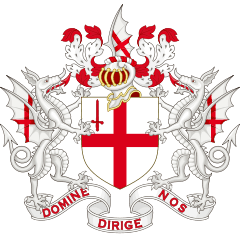Sir Gilbert Heathcote, 1st Baronet
Sir Gilbert Heathcote, 1st Baronet (2 January 1652 – 25 January 1733) was a British merchant and politician who sat in the House of Commons between 1701 and 1733. He was a Governor of the Bank of England and was Lord Mayor of London in 1711.
Early life
He belonged to an old Derbyshire family. He was born in Chesterfield, Derbyshire, the eldest of eight sons of Gilbert Heathcote and his wife, Anne.[2]
He was educated at Christ's College, Cambridge,[3] and went on to become a merchant in London. His trading ventures were very successful; he was one of the promoters of the new East India Company and he emerged victorious from a contest between himself and the old East India company in 1693; he was also one of the first directors of the Bank of England and served as its Governor from 1709 to 1711 and, a second term, from 1723 to 1725.
Political career
In 1702 he became an alderman of the city of London and was knighted; he served as Sheriff of London for 1704 and then elected Lord Mayor of London for 1711, being the last lord mayor to ride on horseback in his procession. In November 1705 he was elected a Fellow of the Royal Society.[4]
In 1700 Heathcote was sent to Parliament as member for the City of London, but he was soon expelled for his share in the circulation of some exchequer bills; however, he was again elected for the city later in the same year, and he retained his seat until 1710.[5] In 1714 he was member for Helston, in 1722 for New Lymington, and in 1727 for St Germans.[6] He was a consistent Whig, and was made a baronet eight days before his death.[2]
Although extremely rich, Heathcote's meanness is referred to by Pope; and it was this trait that accounts largely for his unpopularity with the lower classes. He died in London on 25 January 1733 and was buried at Normanton Hall, a residence which he had purchased from the Mackworths. A monument by the Flemish sculptor Rysbrack is now in Edith Weston church. He had married Hester, daughter of Christopher Rayner, merchant, of London.
Descendants
A descendant, Sir Gilbert John Heathcote, 5th Baronet (1795–1867), was created Baron Aveland in 1856; and his son Gilbert Henry, who in 1888 inherited from his mother the barony of Willoughby de Eresby, became 1st Earl of Ancaster in 1892.[2]
See also
References
- ↑ Heathcote, Evelyn Dawsonne (1899). Account of Some of the Families Bearing the Name of Heathcote which Have Descended Out of the County of Derby. Warren. p. 48. Retrieved 15 September 2017.
- 1 2 3 Genealogical and Heraldic Dictionary of the Peerage and Baronetage of the British Empire. Burke's Peerage Limited. 1914. pp. 96–99. Retrieved 15 September 2017.
- ↑

- ↑ "Library and Archive Catalogue". Royal Society. Retrieved 17 November 2010.
- ↑ "HEATHCOTE, Gilbert (1652-1733), of St. Swithin's Lane, London; Leyton, Essex, and Normanton, Rutland". History of Parliament Online (1690-1715). Retrieved 16 August 2018.
- ↑ "HEATHCOTE, Sir Gilbert (1652-1733), of Low Leyton, Essex, and Normanton, Rutland". History of Parliament Online (1715-1754. Retrieved 16 August 2018.

